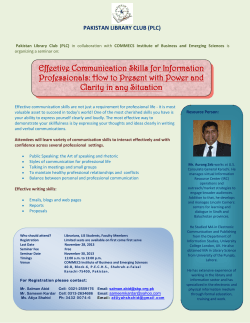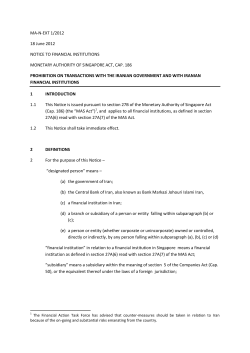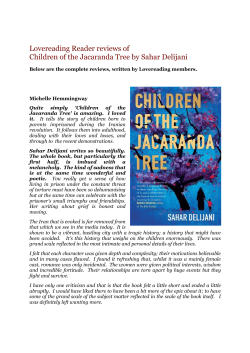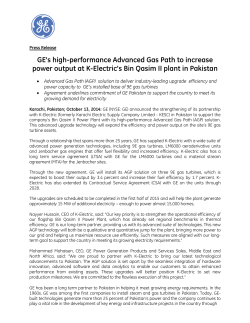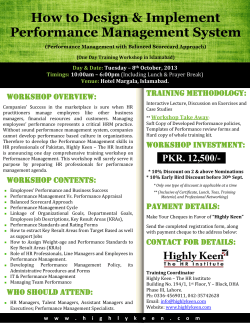
Document 347807
. TUESDAY OCTOBER 21, 2014 AFGHANISTANTIMES We a r e a n a t io n a l in st it u t io n a n d n o t t h e v o ice o f a go v t o r a p r iv a t e o r ga n iza t io n AFGHANISTAN TIMES Editor: Abdul Saboor Sarir Phone No: +93-772364666 E-mail: saboorsareer01@yahoo.com Email: afgtimes@yahoo.com www.afghanistantimes.af Photojournalist: M. Sadiq Yusufi Advisory editorial board Saduddin Shpoon, Dr. Sharif Fayez, Dr. Sultana Parvanta, Dr. Sharifa Sharif, Dr. Omar Zakhilwal, Setara Delawari, Ahmad Takal Graphic-Designers: Mansoor Faizy and Edriss Akbari Marketing & Advertising: Mohammad Parwiz Arian, 0708954626, 0778894038 Mailing address: P.O. Box: 371, Kabul, Afghanistan Our Bank Accounts: Azizi Bank: 000101100258091 / 000101200895656 Printed at Afghanistan Times Printing Press The constitution says Article Three: No law shall contravene the tenets and provisions of the holy religion of Islam in Afghanistan. Editorial Social media role in 2014 presidential polls Social media is expanding our universe as we connect with others or collect information easier and faster than ever, however its neutrality comes under question at times as there is no filter of censorship. If there is any, it’s self-censorship. That’s up to the individual capacity whether they exercise self-censorship or just use it for the spread of hate speech. It means the use of social media may go in any direction. To look at social media causative role, we are going to look at its brighter side and positive influence. Social media is a healthy tool in putting to work in the service of building a better world. However, given the nature of Afghanistan’s political and ethnic shape, it’s highly essential that individual commentators should exercise responsibility. In Afghanistan the slip of tongue or slip of finger tips may spark tensions, which is why social media users need to be careful to local sensitivities. In the presidential election days many social media users consciously and subconsciously used sensitive language, but despite that there was no lack of such users who used this effective tool much constructively and played a constructionist role in public awareness about their right to vote and the influence they could make. To bring the importance and social utility of social media into limelight, a panel was held in Kabul on the second day of the Afghan Social Media Summit to shed light on the role played by social media during the 2014 presidential elections. The pros and cons of social media came under discussion where participants gave different perspectives. The crux of the panel was positive as most of the panel participants were of the view that social media facilitated citizens to engage in the polls and exercise their right to vote. Social media and the right use of citizen journalism proved to be much helpful in uncovering fraudulent practices during the elections by posting pictures and videos on social media. Social media eroded all frontiers as the posts of citizen journalists created transnational dialogues in areas that couldn’t be reached by foreign analysts. Among the nations where literacy rate is higher, the face of news has been changing, but positively. What is important in a country like ours is the language used. It shouldn’t cause tensions among the populace. It’s a causative tool for electoral violence if users indulge in campaign of mudslinging, slandering, and character assassination of political contenders. What is essential is social media shouldn’t be used for spreading hate speech that contribute to ethnic tensions. This media shouldn’t be destructive at all as it can be used to mobilize youth for peaceful elections and it could be used as a pressure tool to mount pressure on leaders to be responsive to the will of the voters. Through this media the youth may shape debates on issues of social, political and cultural importance by shifting discussions on who or what community wants to vie for. When trustworthy content is missing it leads to the misuse of social media therefore trustworthy content has a balanced point view, worth buying for majority. It asks and answers the right questions and tries to inform and educate rather than stirring sensitivities. By Titu Shadow son and Aamna Shahwani After a failed project on a strategic trinity between Pakistan, Iran and Afghanistan that had a bi-product as dominance on Afghanistan the warmth between Iran and Pakistan too was lost as two bosses can’t rule over a single region. The Iranian government was losing cool on Pakistan since last few years but it was never so desperate before but we can see a fierce stand-off between Pakistan and Iran. Since last week there has been cross border exchange of fire between Pakistani Frontier Corps (FC) and Iranian Border Guards resulting the death of 5-6 Pakistani soldiers and number of injuries. Worse, the diplomatic face-off between the two nations stretched itself to Geneva and the issue was internationalized and externalized. Iran’s Parliament Speaker Ali Larijani in a meeting with Senate Chairman Nayyar Hussain Bokhari in Geneva warned against Pakistan backed terrorism in Iran. On the other hand Iranian ambassador to Pakistan Ali Raza Haghighian was summoned by the foreign office, Islamabad on 18th October and was briefed about the ‘aggression’ from Iranian side to the Pakistani posts in Mand area in Kech district. A diplomatic protest was lodged and he was requested to launch an investigation into the matter. The Iranian Border Guards have become furious and in a number of occasions they stormed the Pakistani military convoys killing several FC soldiers and one junior FC officer. Wassey Khan, the spokesperson for FC in Balochistan stated that 30 Iranian Border Guards infiltrated into Pakistani territory and took the area hostage for around 6 hours. The silenced diplomatic face-off between Pakistan and Iran is getting worse day by day. What are the reasons behind all these? One of the reasons is Pakistani Sunni terrorist groups’ unconditional support to the Islamic States that was announced last week. Though Pakistan might discard saying it’s all about non-state actors, the nature of ISI is an open secret. Global intelligence analysts view the Mujahideen as the NonOfficial-Covert (NOC) operatives of the ISI. The reach and potential of the Mujahideen inside Pakistani intelligence and military establishment is clear from the murder of Pakistani Special Service Group (SSG) military operations’ head Major General Amir Faisal by his junior officers like Colonel Haroon and some Majors. Major General Amir was murdered because of his ‘inability’ to save his famous journalist sister Nadira Naipaul from entering into interfaith marriage with an Indian nationalist writer Lord Suraj Prasad Naipaul. This is the level extremism has seeped into Pakistani establishment where even a Major can assassinate the Major General at will. Iran believes that the Islamic States (IS) has the backing of Pakistan. The IS has opened its Balochistan chapter named Lashkar-e-Khurasan (LeK) in Balochistan whose primary agenda is to weaken and eliminate the Shia Muslims from Balochistan along with the Hindus of the area. LeK has been involved in massacring the Zikris which don’t fulfill the Islamic standard set by the IS. Iran believes that the Pakistan’s creation of LeK is the indication of their long term venom against Iran. The anti-Shia sentiment of IS will reflect itself in terms of terrorism inside the Iranian territory. Though Pakistan maintains the image of a coordinator among the two warring sects of Islam, the Shias and Sunnis and tries to unite them under one umbrella with the excuse of global jihad, Pakistan has to appease its Sunni extremists as majority of the Pakistani population is Sunni. Iran also believes that the Baloch rebels inside Sistan-waBalochistan, the Baloch populated province in Iran, are being sponsored by Pakistani agencies. Strategically the case of the Iranian Baloch rebels is a complicated matter. The Balch rebels inside Pakistan do have a secular and socialist cover but just cross the border and they will be found to be Sunni extremists. There is no meaning being an Islamic extremist in Pakistan and ask for partition and as a result the Baloch have to take the socialist ideology which is not needed in Iran to further the separatist or ‘liberation’ agenda. Iran is a Shia nation and the Iranian Baloch are Sunnis and that’s why the main separatist organization in Sistan is Jandullah-Iran. Despite joint adventures by Baloch rebels in Pakistan and Iran there has never been an official acceptance of a bond between the two rebel units. However Iranian officials believe that Pakistan is supporting terrorism inside Iran and backing the Baloch Sunni extremists, who have chosen the path of Sunni extremism to have a separate land from Shia Iran. The Iranian military officials have delivered statements in the media alleging Pakistan trained militants infiltrating Iranian Territory. A top Revolutionary Guard commander Abdollah Araghi categorically delivered a statement to the State TV on Saturday that they have prepared a dossier on Pakistani infiltration bids and Pakistan backed terrorism inside Iranian territory and it will be submitted to the Iranian government’s political and security officials. Iran-Pakistan face-off was always there but Iran never wanted to lose Pakistan that could worsen the security of Iran due to the IranArab stand-off and Shia-Sunni stand-off, however now Iran is in Can they all be winners? By Dr Ahmed Mokhtar AMID A cautious optimism, Cairo hosted last week the second meeting of the tripartite committee, which is responsible for studying the situation of the Ethiopian Renaissance dam, with the participation of ministers from Egypt, Sudan and Ethiopia. The Egyptians recalled the way the Muslim Brotherhood group dealt with this matter of strategic importance when they were in power, and compared that with how the current political leadership is handling it. The Muslim Brotherhood’s approach in dealing with the Renaissance dam was one of the main reasons that made Egyptians feel the inability of the group to lead Egypt safely, especially after broadcasting a live feed of a meeting between the former Egyptian president Mohammed Mursi with several political figures while discussing different scenarios to deal with Ethiopia regarding the dam, including threatening the latter militarily, which was an unprecedented and unacceptable way of dealing with a serious crisis. The Ethiopians reacted to that televised meet- ing by insisting on completing the dam construction project in a shorter-than-planned timetable. On the other hand, the current Egyptian leadership is approaching the crisis politically, and is trying to solve the problems through negotiations which were halted during the period between January to August of this year following a failure in reaching an agreement on the recommendations of the international committee of experts concerning the completion of the dam’s studies. Negotiations resumed after Egypt’s President Abdul Fattah Al Sisi met with the Ethiopian Prime Minister, Hailemariam Desalegn, on the sidelines of the African Union Summit last June, and both sides stressed on their good intensions towards each other. Several meeting took place afterwards between representatives of Egypt, Sudan and Ethiopia, with the last one held in Cairo last week to decide on choosing a consulting office to be responsible for preparing complementary studies recommended by the international committee in its report last year. It concerns assess- ing the environmental, social and economic impacts of the dam on Egypt and Sudan, as the river Nile’s downstream states. Last week’s meeting was coincided with Al Sisi’s eagerness to show support for better relations with Sudan and Ethiopia. This positive atmosphere is giving hope to the Egyptian people that their country is winning back its due share in the region, while knowing that water is a lifeline to Egypt, since more than 90 per cent of its people live along the banks of the Nile. It is important to note that Egyptians do not deny any of the Nile basin countries’ right to establish water projects, as long as they do not harm Egypt in any way. That’s why Egyptians remain wary of the current crisis with Ethiopia. The Egyptian fears are not related to what some unofficial reports speculate about the collapse of the dam as a result of geological factors. Moreover, early studies of the construction of the Renaissance dam said its height will only be at 84.5 meters with a storage capacity of 11.1 billion cubic meters, and might need to be ex- search of a trustworthy and harmless strategic ally. Iran is counting on India. India and Iran has always been business partner and the gaspipeline project between Iran and India has always been an apple of discord for Pakistan which always poked nose into this matter and blackmailed both the nations. Iran has also desperately exploited the goodwill of India by ideologically and in other ways supporting the Kashmiri jihad. Iran wasn’t donating India the oil and gas it receives but India purchased that, still the political behavior of Iran to India was somewhat to master and slave, credit might go to the spineless governance of India at that time however now the situation swiftly changed and drastic strategic and diplomatic games are being played in India. China, Vietnam, Japan, Australia, USA, Russia, Israeleveryone wants ally with India whose new government is now deciding the terms of alliance. Iran has the confidence that India can contain the Pakistani threat and unnecessary nose-poking in IndiaIran matters. That is why Iran can now compromise Pakistan for India. While the Modified India is confident and trustworthy, Pakistan can’t be trusted as a strategic ally by any single nation. Pakistan’s political character is like a prostitute sleeping with different strategic partners in morning and evening. On one hand it receives military aid from America and on the other hand it conducts joint military exercises with China. Pakistan maintains relation with both Iran and Arab. A Pakistan which was formed by religious extremist leaders from Shia sect, has now become the worst house for Shias and been taken over by Sunni extremists. Iran has legitimate reasons to run out of goodwill for Pakistan and it is running out. The authors are strategic analysts based in Quetta and New Delhi. tended to 90 meters and 24.3 billion cubic meters of storage capacity. The Egyptian leadership is certain about the necessity to reach an agreement between all parties involved, and that Ethiopia shares the same view, especially if the complementary studies confirmed the Egyptian fears and suggested the construction of the dam according to the early studies. This way, all the parties will come out of the crisis in a win-win situation. Egypt’s fears will come to an end and Ethiopia will get rid of the finances’ burden, which is estimated at $8 billion. While the construction of the Gilgel Gibe III dam, which was started in 2006, is yet to be finished because of the inability to provide $2 billion, and the reluctance of international financial institutions to fund water dams because they are not economically viable. Additionally, Sudan will also come out as a winner since it doesn’t have to worry about a possible catastrophic collapse of the Renaissance dam, besides strengthening ties with Egypt and Ethiopia and benefiting from that as a support during its strained relations with South Sudan.— (Khaleej Times) Dr Ahmed Mokhtar is the deputy editor in chief of Al Ahram Al Masaai. Subscription Rates Categories Annual Six Months Fee Afg: 3600 Afg: 1800 International Organization $200 per year Afghanistan Times at your door step For fast delivery service Afghanistan Times seeks the names, addresses of your organizations and the number of copies you want. World This document was created with Win2PDF available at http://www.win2pdf.com. The unregistered version of Win2PDF is for evaluation or non-commercial use only. This page will not be added after purchasing Win2PDF.
© Copyright 2025
